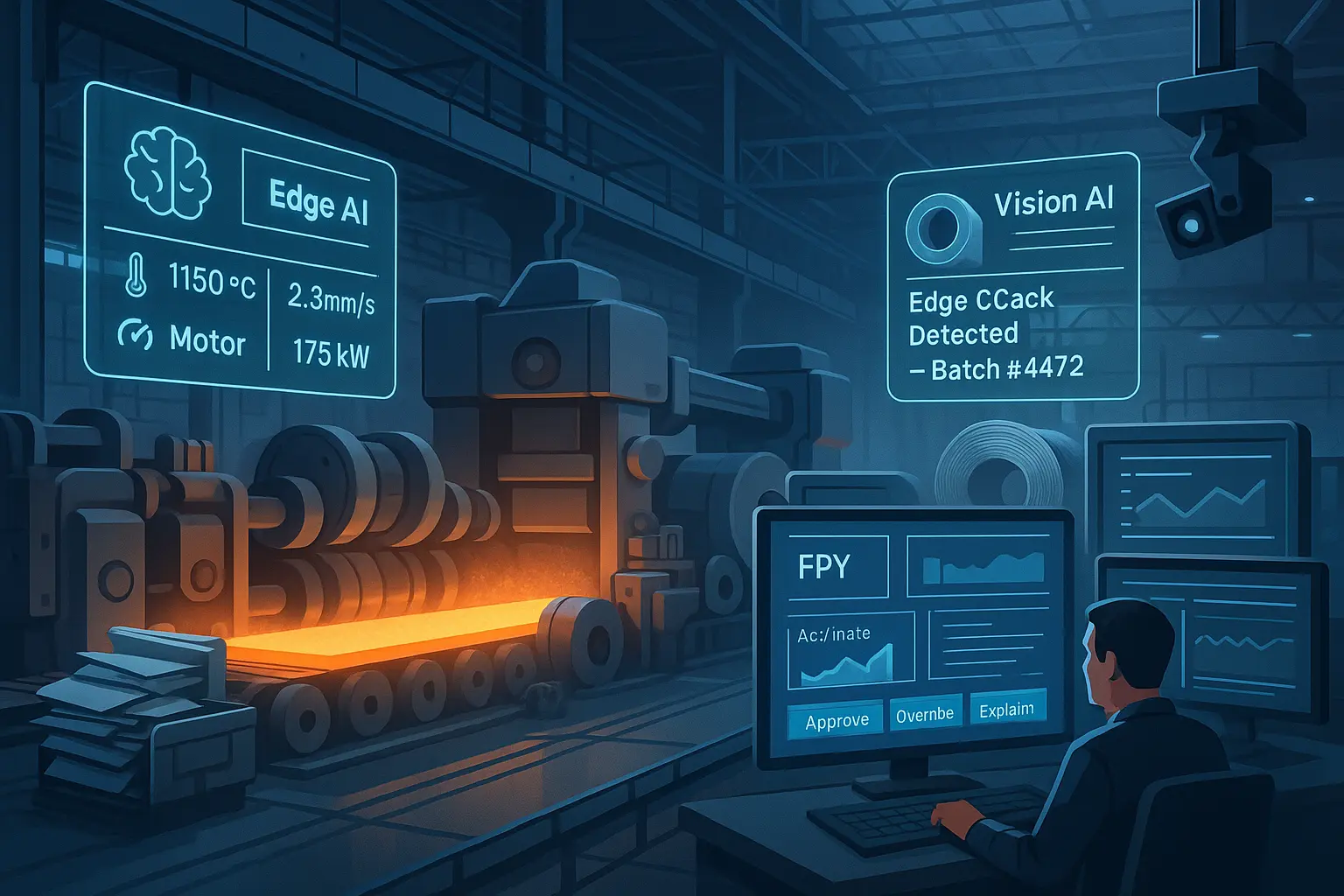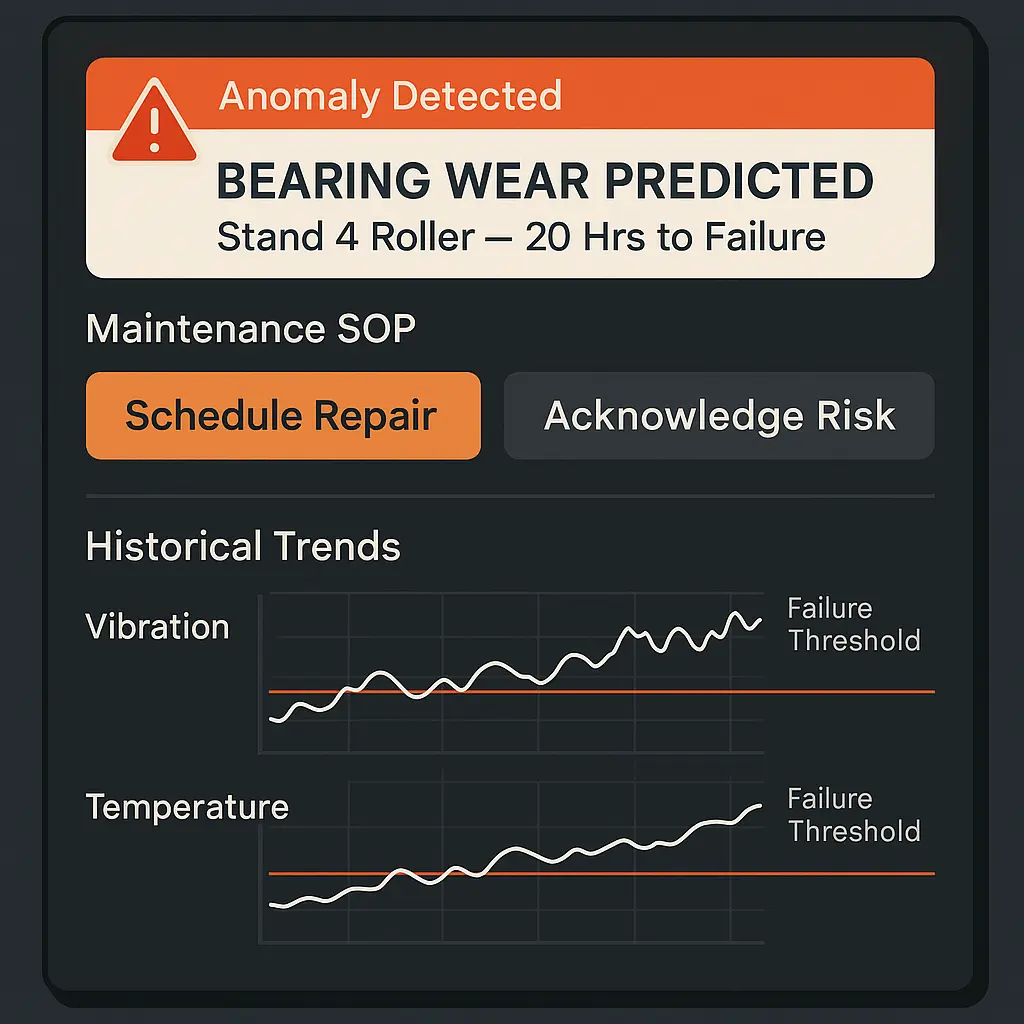AI Optimization in Steel Manufacturing
Executive Summary
A global steel manufacturer operating multiple high-capacity plants in Asia partnered with Synaptron to implement an AI-based operational intelligence solution at the OT layer. The goal was to optimize line throughput, reduce unplanned downtime, and improve defect detection during rolling and finishing operations. Within 6 months of deployment, the plant realized:
- 18% reduction in unplanned downtime
- 22% increase in first-pass yield (FPY)
- Real-time visibility into 47+ process parameters
- Break-even ROI in under 9 months
This AI deployment transformed production from reactive firefighting to proactive decision-making, driven by real-time analytics and OT-integrated insights.
Challenge
Process Inefficiencies and Data Blind Spots at the Plant Floor
The plant was facing operational bottlenecks typical in large-scale steel manufacturing:
Unplanned Line Stoppages from Hidden Anomalies
Unpredictable line stoppages during rolling and pickling, often due to unmonitored equipment anomalies or raw material inconsistencies.
Delayed Defect Detection Causing Rework and Scrap
Delayed defect detection, with surface defects and edge cracks often identified post-process, resulting in rework, scrap, and downstream delays.
Siloed Data Hindering Operational Visibility
Siloed data from PLCs and SCADA systems with no centralized visibility, limiting operational diagnostics and preventive action.
Manual Logs Blocking Real-Time Response
Manual reporting and logging, making real-time reaction to anomalies impossible.
Inefficient Shift Handoffs Without Actionable Insights
Inefficient shift transitions with lack of actionable insights passed between teams.
Despite the presence of high-end control systems, the absence of intelligence on top of the data limited operational agility and asset utilization.
Solution
AI-Powered Operational Intelligence Layer Integrated with OT Systems
Synaptron deployed a lightweight, edge-friendly Industrial AI platform that integrated directly with the plant’s OT infrastructure (SCADA, DCS, PLCs). The system collected, processed, and analyzed streaming data from 1,200+ sensor points across the hot strip mill, pickling, and finishing lines.
Key components included:
- Edge AI Agents for Real-Time Signal Analysis
- AI models continuously analyzed vibration, temperature, load, and speed signals to detect early signs of mechanical anomalies in drive motors, rollers, and coolant pumps.
- Instant alerts were pushed to control room operators with clear diagnostics (e.g., bearing wear predicted in stand 4 roller, 20 hrs before failure risk).
- Defect Pattern Recognition Using Vision + AI
- Existing line cameras were used to capture high-res images of coils. Synaptron deployed computer vision models trained on historical defect patterns to flag surface defects and edge cracks in real time.
- Anomalies were logged automatically with metadata (batch, shift, temperature), enabling root cause analysis.
- KPI Dashboards for Shift Leaders & Operations Heads
- A plant-wide AI dashboard provided actionable metrics: FPY, downtime causes, average coil processing time, and top 5 defect types by line.
- Shift reports were automated with embedded insights, allowing smoother handovers and accountability tracking.
- Feedback Loop for Continuous Learning
- Operator feedback on AI recommendations was looped back into model retraining, improving accuracy and trust over time.


Outcome
Quantifiable Impact in Under 6 Months
The implementation delivered measurable business outcomes across three key dimensions:
- 18% Reduction in Unplanned Downtime
Predictive anomaly detection enabled early maintenance and intervention—especially in motors and pumps—averting stoppages and breakdowns. - 22% Improvement in First-Pass Yield (FPY)
Real-time defect detection allowed operators to react faster and correct process drift before scrap was produced. - Faster Decision-Making & Improved Collaboration
Unified dashboards and automated alerts created a culture of proactive monitoring. Operations heads no longer waited for EOD reports—they acted in real time. - High User Adoption
The intuitive design, native OT integration, and operator involvement from the pilot phase ensured rapid adoption without resistance. - Return on Investment in <9 Months
Savings from reduced scrap, better uptime, and higher throughput covered the full implementation cost in under 9 months.
Future
Scaling AI Across Global Sites and Additional Use Cases
With strong ROI from the first plant, the manufacturer has initiated a multi-phase scale-up:
Rollout to 3 additional plants
in India, with localized model retraining
Integration with MES & ERP systems
to close the loop between operations and business planning
Use of LLMs (Large Language Models)
to create conversational shift assistants that interpret KPIs, guide decisions, and answer operator queries
Digital Twin Development
to simulate line behavior under different process configurations before implementation